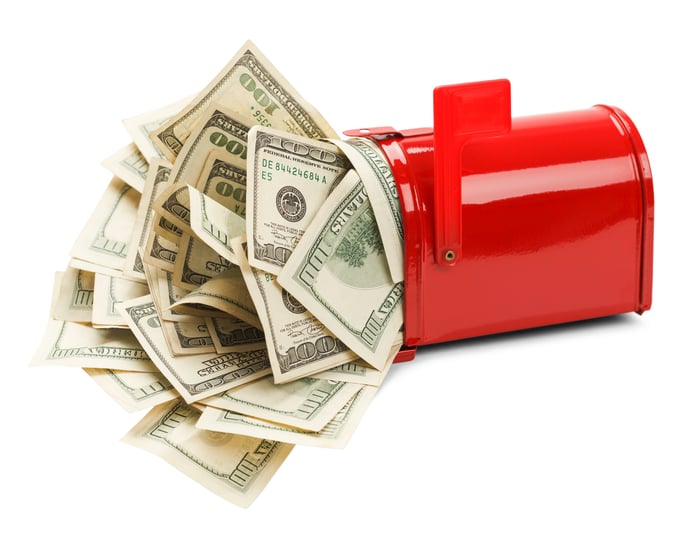A bond ladder can be an incredibly valuable tool in your investing arsenal once you reach the point of taking money out of your portfolio. If you're preparing to retire, have kids on a path to college, plan to down-stress your job to a lower-paying one, or otherwise expect to spend money from your investments, a bond ladder may be for you. Still, they can be a bit complicated for those who haven't used them before.
Bond ladders take advantage of key characteristics of bonds to provide a very high likelihood of giving you cash when you need it to cover your costs. Bonds have well-defined payment and maturity schedules, making them ideal for matching the bonds to when you need the money. In addition, bonds are a higher-priority financial obligation than any stock-related payment, making it very likely that if an issuer can make its bond payment, it will.

Image source: Getty Images.
Step 1: Determine your cash-flow needs
Say you're planning on retiring and expect to need around $3,000 per month from your portfolio to cover your costs of living. You would plan for a bond ladder that generates either $3,000 per month or $9,000 per quarter (to cut back on commissions) from maturing bonds. You would also want to boost that amount gradually over time to handle inflation -- say to $10,000 per quarter after a few years.
Step 2: Decide on the target length of your bond ladder

Image source: Getty Images.
The benefit of bond investing is the higher certainty compared with stocks. The downside, particularly in today's relatively low-interest-rate environment, is that your expected return as an investor is lower in bonds than in stocks. As a result, you'll want a bond ladder that's long enough to get you through the dips inherent in stock market investing, but not so long that you jeopardize the returns you need for your long-term future.
A great rule of thumb is that you don't want money invested in stocks that you expect to spend within the next five years. That makes five years the smallest recommended length of a bond ladder for a retiree. On the flip side, unless you have saved substantially more than you technically need, extending your bond ladder much beyond 10 years risks sacrificing long-term returns for the sake of stability. For reasons we'll get to in Step 6, seven years may well be the "Goldilocks" length for many retirees.
Step 3: Pick your spot on the risk curve
While bonds carry a higher priority and a lower risk than stocks, they are not entirely risk-free investments. Bond ratings generally range from AAA to D -- with AAA considered bonds from the safest issuers and D being bonds in default -- that have already failed to keep their promised payments. Ratings in the BBB range or better are considered investment grade.
As with most investments, there's a trade-off between risk and potential reward, with lower-rated bonds offering higher yield in exchange for the higher risk of default. If you're looking for bonds to provide you cash flow in retirement, you'll probably want to stick with investment-grade offerings to improve the likelihood that the money will be there for you when you need it.
Step 4: Screen for and buy the bonds that meet your nearest-term needs

Image source: Getty Images.
Most online brokers offer bond-screening capabilities. If you input what ratings you're looking for and the time frame you're looking for the bonds to mature, the screener will return to you a list of bonds that meet your expectations. Search through the list for one or more issuers that meet your criteria for the soonest time frame you need the money and that you believe will meet its financial obligations throughout the life of your bond.
Often, brokers will even have links to bond-rating reports to help you figure out whether the issuer has any unique risks you should know about. In addition, if you're buying bonds for a bond ladder, you can ignore offerings with more complicated features such as conversions or early call schedules. Instead, stick with plain vanilla bonds that offer set coupon payments and maturity dates. Once you're satisfied with what you find, place your order to buy the bonds.
If this sounds simpler than stock investing, in many respects, it is. Since typical bonds have set payment schedules, what you're looking for is a sense that the issuer will pay you what it promised, when it promised, rather than for a potential of a superior return. Higher-quality bonds typically move more or less together as a class, based on the issuer's rating and maturity, although individual bonds can move differently if there's a change in the issuer's credit quality.
Step 5: Build out your ladder to your starting target length
Once you get the hang of screening for and buying bonds, repeat the process until your bond ladder reaches your target length. You will also want to diversify between issuers to protect yourself from a total catastrophe should one default on you. This can require a substantial amount of cash. If you're building a seven-year bond ladder for $3,000 a month in maturing bonds, you'll need somewhere in the neighborhood of $252,000 to set it up -- even more if you're adjusting for estimated inflation.
This is why it's important to find the right balance between your stock investments to cover your longer-term needs and your bond ladder to cover your shorter-term needs for cash. The rest of your money can remain invested in stocks to help provide your longer-term needs. If, for example, you were starting with a $600,000 portfolio, you'd have $252,000 in your bond ladder and be able to keep around $348,000 in stocks.
Step 6: Manage your bond ladder over time

Image source: Getty Images
Every month, when your bonds mature, the cash you get from those maturing bonds becomes available to cover your spending needs. When those bonds mature, however, your ladder gets one rung shorter as all your remaining bonds get closer to their maturity dates. To keep the ladder going, you will need to buy more bonds that mature after the latest maturity date you own.
You will generally have three sources of cash to extend your bond ladder: interest from your existing bonds, dividends from your stocks, and the sale of some of your stocks. If the stock market is performing as you hope, you can simply trim some of your appreciated stock holdings to supplement your dividends and interest payments to extend your bond ladder by a month. If the market is really rising rapidly, you can even use your good fortune to extend the ladder even farther.
If, on the other hand, the market is throwing a fit, as it did late last year, you can simply hold off on selling your stocks to buy bonds. Your bond ladder will shrink by a month, but because you started with several years' worth of bonds in your ladder, you don't need to immediately sell those stocks to cover your spending needs. Instead, you have the luxury of waiting until the market shows signs of recovery before extending your bond ladder.
Just be sure that once the market shows signs of life, you work toward rebuilding your bond ladder to your target length, so that it can continue to serve you as long as you need it. That's why it can be valuable to start with a somewhat longer bond ladder than the five year minimum. With a longer bond ladder at the start, you can afford to wait that much longer before all the rungs mature and put you in the position of being forced to sell stocks to cover your costs of living.
Be in control of your money when you need to spend it
With a well-constructed bond ladder as part of your plan, you give yourself a strong chance of having the money you need when you need it, while still keeping money invested for your longer-term future. That makes bond ladders an incredibly powerful tool for your financial planning needs. You can use them whether you're looking forward to retirement, anticipating college expenses, or facing any other expected major expense that's more than you can handle from your paycheck alone.




